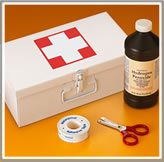Simple Steps Everyone Can Take
|
Natural
disasters are a fact of life. Each area
of the country has its own challenges,
from hurricanes on the Atlantic and Gulf
Coasts to tornados in the Plains and
earthquakes in California. Regardless of
where you live, it's important to have
plans in place to ensure that you and
your family are prepared should an
emergency arise.
Begin by researching which types of
events could occur in your community:
|

|
-
Contact local authorities to learn
how community alerts are issued and
the evacuation routes you will need
to follow.
-
Inquire about emergency plans at
work, school, and any other
locations that family members
frequent on a regular basis.
-
Determine how to care for your
pet(s) since most temporary shelters
only permit service dogs to enter.
Start by visiting the American Red
Cross website's Animal Safety
section to learn about suggested
alternatives (www.redcross.org).
|
|
|
|
Next, develop a Family Emergency Plan:
|
-
Create contact information cards for
each family member.
-
Select a reliable out-of-state
relative/friend who family members
should contact
if local communications are down.
-
Establish home escape routes and
practice them.
-
Learn how to shut off your
utilities.
-
Procure proper insurance coverage
and protect your vital records.
-
Create a short list of what to take
in case of a fire.
|
|
|
|
Finally, create a Disaster Supply Kit
for your home, your car, and your
office. Your home kit should include:
|
-
Food - Select prepackaged,
ready-to-eat food and beverage items
that your family will enjoy. Try to
avoid anything that's too salty in
case the water supply is limited.
-
Water - Store one gallon of water
for each family member per day, and
plan on a minimum of three days.
-
First Aid Kit and essential
medications.
-
Non-electric can opener, knife, and
utensils.
-
Battery-operated radio, flashlights,
batteries, pens and paper.
-
Be sure to review the contents of
the kit every six months, and
replace anything that's about to
expire.
|
Your office and car kits should contain a pared
down collection of the items mentioned above, as
well as comfortable shoes. In addition, you'll
want to add flares and jumper cables to your
car's inventory.
If you found this information to be helpful and
would like to learn more, you may want to visit
one or more of the following websites:
www.redcross.org,
www.72hours.org,
and
www.fema.gov/areyouready.
|
